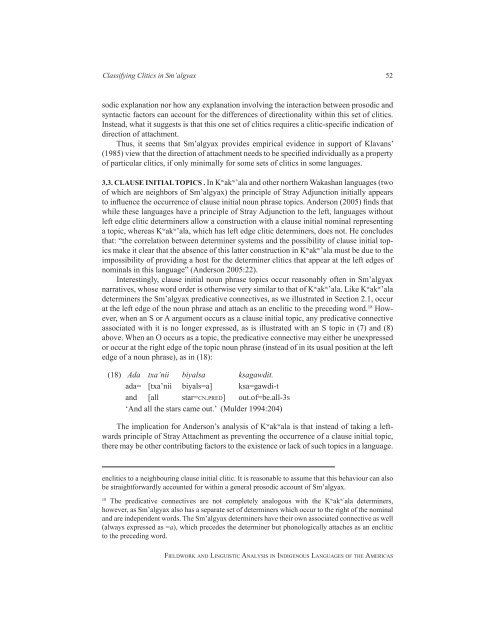Fieldwork and Linguistic Analysis in Indigenous ... - ScholarSpace
Fieldwork and Linguistic Analysis in Indigenous ... - ScholarSpace
Fieldwork and Linguistic Analysis in Indigenous ... - ScholarSpace
You also want an ePaper? Increase the reach of your titles
YUMPU automatically turns print PDFs into web optimized ePapers that Google loves.
Classify<strong>in</strong>g Clitics <strong>in</strong> Sm’algyax 52<br />
sodic explanation nor how any explanation <strong>in</strong>volv<strong>in</strong>g the <strong>in</strong>teraction between prosodic <strong>and</strong><br />
syntactic factors can account for the differences of directionality with<strong>in</strong> this set of clitics.<br />
Instead, what it suggests is that this one set of clitics requires a clitic-specific <strong>in</strong>dication of<br />
direction of attachment.<br />
Thus, it seems that Sm’algyax provides empirical evidence <strong>in</strong> support of Klavans’<br />
(1985) view that the direction of attachment needs to be specified <strong>in</strong>dividually as a property<br />
of particular clitics, if only m<strong>in</strong>imally for some sets of clitics <strong>in</strong> some languages.<br />
3.3. CLAUSE INITIAL TOPICS . In K w ak w ’ala <strong>and</strong> other northern Wakashan languages (two<br />
of which are neighbors of Sm’algyax) the pr<strong>in</strong>ciple of Stray Adjunction <strong>in</strong>itially appears<br />
to <strong>in</strong>fluence the occurrence of clause <strong>in</strong>itial noun phrase topics. Anderson (2005) f<strong>in</strong>ds that<br />
while these languages have a pr<strong>in</strong>ciple of Stray Adjunction to the left, languages without<br />
left edge clitic determ<strong>in</strong>ers allow a construction with a clause <strong>in</strong>itial nom<strong>in</strong>al represent<strong>in</strong>g<br />
a topic, whereas K w ak w ’ala, which has left edge clitic determ<strong>in</strong>ers, does not. He concludes<br />
that: “the correlation between determ<strong>in</strong>er systems <strong>and</strong> the possibility of clause <strong>in</strong>itial topics<br />
make it clear that the absence of this latter construction <strong>in</strong> K w ak w ’ala must be due to the<br />
impossibility of provid<strong>in</strong>g a host for the determ<strong>in</strong>er clitics that appear at the left edges of<br />
nom<strong>in</strong>als <strong>in</strong> this language” (Anderson 2005:22).<br />
Interest<strong>in</strong>gly, clause <strong>in</strong>itial noun phrase topics occur reasonably often <strong>in</strong> Sm’algyax<br />
narratives, whose word order is otherwise very similar to that of K w ak w ’ala. Like K w ak w ’ala<br />
determ<strong>in</strong>ers the Sm’algyax predicative connectives, as we illustrated <strong>in</strong> Section 2.1, occur<br />
at the left edge of the noun phrase <strong>and</strong> attach as an enclitic to the preced<strong>in</strong>g word. 18 However,<br />
when an S or A argument occurs as a clause <strong>in</strong>itial topic, any predicative connective<br />
associated with it is no longer expressed, as is illustrated with an S topic <strong>in</strong> (7) <strong>and</strong> (8)<br />
above. When an O occurs as a topic, the predicative connective may either be unexpressed<br />
or occur at the right edge of the topic noun phrase (<strong>in</strong>stead of <strong>in</strong> its usual position at the left<br />
edge of a noun phrase), as <strong>in</strong> (18):<br />
(18) Ada txa’nii biyalsa ksagawdit.<br />
ada= [txa’nii biyals=a] ksa=gawdi-t<br />
<strong>and</strong> [all star=cn.Pred] out.of=be.all-3s<br />
‘And all the stars came out.’ (Mulder 1994:204)<br />
The implication for Anderson’s analysis of K w ak w ala is that <strong>in</strong>stead of tak<strong>in</strong>g a leftwards<br />
pr<strong>in</strong>ciple of Stray Attachment as prevent<strong>in</strong>g the occurrence of a clause <strong>in</strong>itial topic,<br />
there may be other contribut<strong>in</strong>g factors to the existence or lack of such topics <strong>in</strong> a language.<br />
enclitics to a neighbour<strong>in</strong>g clause <strong>in</strong>itial clitic. It is reasonable to assume that this behaviour can also<br />
be straightforwardly accounted for with<strong>in</strong> a general prosodic account of Sm’algyax.<br />
18 The predicative connectives are not completely analogous with the K w ak w’ ala determ<strong>in</strong>ers,<br />
however, as Sm’algyax also has a separate set of determ<strong>in</strong>ers which occur to the right of the nom<strong>in</strong>al<br />
<strong>and</strong> are <strong>in</strong>dependent words. The Sm’algyax determ<strong>in</strong>ers have their own associated connective as well<br />
(always expressed as =a), which precedes the determ<strong>in</strong>er but phonologically attaches as an enclitic<br />
to the preced<strong>in</strong>g word.<br />
fieldwork <strong>and</strong> l<strong>in</strong>guistic analysis <strong>in</strong> <strong>in</strong>digenous languages of the americas

















